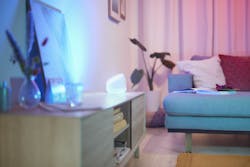Signify beefs up its WiZ line with lamps and luminaires
With pandemic-related stay-at-home trends still buoying consumer purchases of smart lighting products, Signify has boosted its WiZ line with a number of additions, including tabletop orbs as well as slim ceiling lights, with both categories including variable circadian settings.
WiZ is the lower-price alternative to Signify’s more feature-rich Hue line. WiZ products use Wi-Fi wireless controls. Hue deploys Zigbee wireless.
The WiZ line has been centered around bulbs, with a few standalone lamps available in the past but with the number and emphasis now increasing via the addition of orb-shaped WiZ Hero and WiZ Squire table lamps and a couple of ceiling lights, the WiZ Tunable White ceiling lights and the dimmable WiZ Adria ceiling lights.
The Hero table orb delivers white and colored light and is pre-programmed with rudimentary wakeup and bedtime modes, emitting different spectral content in the morning and in the evening. It includes a tap control for basic functions; a Wi-Fi connected app supports more functions such as spectral adjustments and voice control. Signify introduced a WiZ Hero about a year ago; it was not immediately clear what the new Hero adds over the previous model.
The new Wi-Fi controlled WiZ Squire table orb delivers variable spectral white light as well as colors. It has a slanted top that can splash light onto a wall while the rest of the orb emits local light.
The WiZ Tunable White ceiling lights are intended for bedrooms and living rooms, and the WiZ Adria dimmable lights are intended for kitchens, bathrooms, and hallways. The idea of Adria is to allow users to avoid dazzling bright lights when they get up at night; the Wi-Fi connected app supports voice controls to turn down the intensity, for instance.
Signify is offering the table lamps in Europe and in the US, beginning this month priced at €49.99 and €54.99 for Hero and Squire respectively, and $49.99 and $59.99 in the US. The ceiling lamps are available in Europe only, with Adria priced at €26.99 and Tunable White priced starting at €53.99.
The company also added colored spots to the WiZ line, available in Europe only.
“We make commercialization decisions based on individual market requirements,” a Signify spokesperson said when LEDs Magazine asked via e-mail why only some of the new products are available in the US.
The new WiZ products come a few days after Signify also added to its more upmarket Hue line. New Hue products and features included an integration with music service Spotify, enabling Hue lights to change in response to the feel of a tune.
Signify launched a concerted effort a year ago to raise WiZ’s profile by adding ease-of-use features to make the lower-cost alternative to Hue more appealing.
According to Signify CEO Eric Rondolat, WiZ and Hue have benefited from consumers’ tendency to purchase home products during the world health crisis, as they have engaged in fewer activities outside the house. How long this trend might last is debatable.
“During the crisis, a lot of consumers are going online, and they’re looking at refurbishing or improving their homes, and we have benefited from that,” Rondolat said on a conference call with analysts in late July. “But when we benefit from a customer, who’s entering in our ecosystem, we also benefit from the fact that we know they’re going to come back and buy more. You don’t equip your house fully in one go. You go step by step. So entering in the system, it is, for us, a quasi-certainty that we’re going to have new buyers. This is what is happening at this point in time.”
Rondolat believes that the momentum will continue.
“What is even more interesting on that category is the added education or the accelerated education that the crisis has been doing,” he continued, in response to a question from analyst Marc Hesselink of Amsterdam-based ING Group. “So we see now many consumers that would have gone to that type of product much later, already being into it and investing in the category. Once again, Marc, what is important to consider is, if we’re touching theoretically close to 100% of the consumers with our non-connected consumer offers, we are not even touching 5% of the consumer base in the connected smart home category. So there’s a fantastic potential ahead.”
The WiZ and Hue lines are the bulk of Signify’s Digital Products group, which in the second quarter ending June 30 registered a 20.4% increase in comparable sales compared to the second quarter of 2020. By comparison, the group that sells lighting products and services to the commercial market, called Digital Solutions, grew less — by 12.6%. Digital Solutions remains Signify’s largest business group, however. It had nominal second quarter sales of €837 million (US$989M), compared to Digital Products’ €553M ($654M). Total sales for the quarter were €1.6B ($1.9B), including the company’s Conventional Products group.
This continued a strong WiZ and Hue performance from the first quarter, when Signify also cited the pandemic as a stimulus for home purchases.
In another move to strengthen its home smart lighting products, Signify is making both WiZ and Hue compatible with other home connected devices such as smart doorbells, locks, windows, and TVs, via the Matter protocol.
Editor's note: Signify reports financials in Euros. US dollar conversions are based on currency rates at time of publication.
MARK HALPER is a contributing editor for LEDs Magazine, and an energy, technology, and business journalist ([email protected]).
For up-to-the-minute LED and SSL updates, why not follow us on Twitter? You’ll find curated content and commentary, as well as information on industry events, webcasts, and surveys on our LinkedIn Company Page and our Facebook page.

Mark Halper | Contributing Editor, LEDs Magazine, and Business/Energy/Technology Journalist
Mark Halper is a freelance business, technology, and science journalist who covers everything from media moguls to subatomic particles. Halper has written from locations around the world for TIME Magazine, Fortune, Forbes, the New York Times, the Financial Times, the Guardian, CBS, Wired, and many others. A US citizen living in Britain, he cut his journalism teeth cutting and pasting copy for an English-language daily newspaper in Mexico City. Halper has a BA in history from Cornell University.






